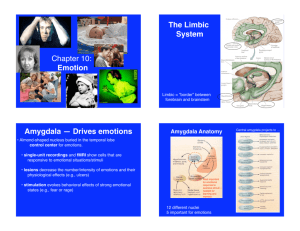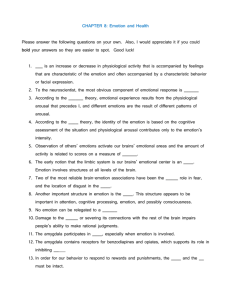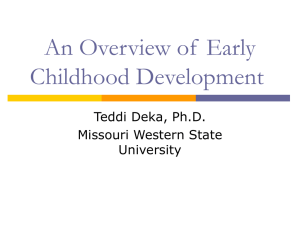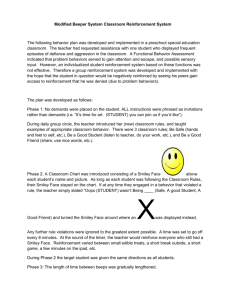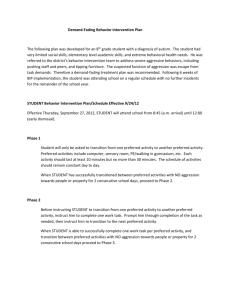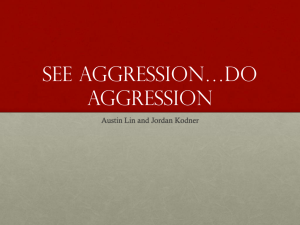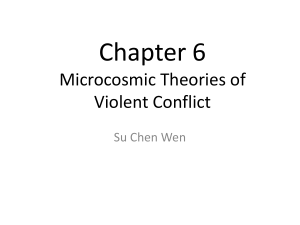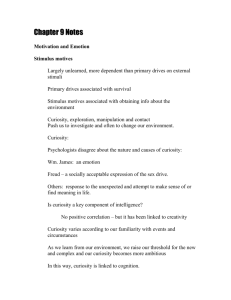Anger Management by Vaughn Kaser, MCAT, MT-BC
advertisement
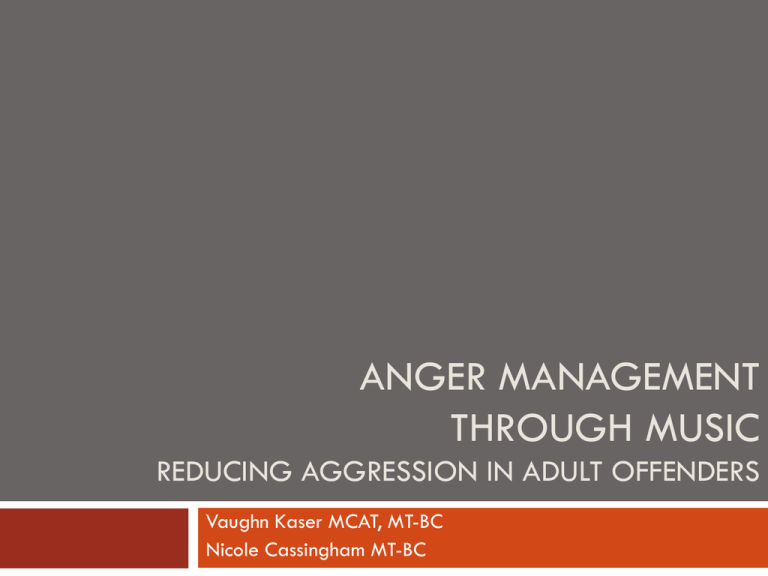
ANGER MANAGEMENT THROUGH MUSIC REDUCING AGGRESSION IN ADULT OFFENDERS Vaughn Kaser MCAT, MT-BC Nicole Cassingham MT-BC Atascadero State Hospital Maximum Security Forensic Psychiatric State Hospital 1275 Patients Beds Interdisciplinary Teams Types of patients PC 1370 - Incompetent to Stand Trial PC 2962 - Mentally Disordered Offenders on Parole PC 1026 - Not Guilty By Reason of Insanity PC 2684 - Mentally Disordered Inmates The Recovery Model Philosophy THE ELEMENTS The Wellness and Recovery Foci 1 Psychological 5 Substance Abuse 2 Social Skills 3 Dangerousness and Impulsivity 6 Medical, Health, Wellness 9 Occupational Skills 10 Leisure and Recreation 7 Legal 4 Hope and Spirituality 8 School and Educational 11 Community Integration Focus 3 Dangerousness and Impulsivity The Lesson Plan Topics Objectives Method Outcome Measures Materials Schneck, Daniel J. and Berger, Dorita S. (2006). The Music Effect. London: Jessica Kingsley Publishers. Taylor, Dale B. (1997). Biomedical Foundations of Music As Therapy. Saint Louis: MMB Music, Inc. topics Flight Fight Fright Disconnecting Aggression Increasing Awareness Ideas and Beliefs Reducing stress and tension Routine Interventions Instruments Used Control Out of Cycle into Civility My Own Prison Can this be true? Expressive Guided Improvisation Cathartic Release Anger Management Does Catharsis Help Manage Anger? Concerns: Could We Be… Encouraging Physical Aggression? Supporting Physical Acting Out? Literature Review Steven Koelsch Music in the Treatment of Affective Disorders: An Exploratory Investigation of a New Method For Music-Therapeutic Research Music Perception Vol 27, Issue 4 “Mounting evidence indicates that making music, dancing, and even simply listening to music activates a multitude of brain structures involved in cognitive, sensorimotor, and emotional processing” “Music can strongly affect emotion and mood…emotional effects form an important basis for possible interventions using music in the treatment of disorders related to autonomic (below the level of consciousness, controls visceral functions) endocrine (hormones-adrenal gland-stress), and immune system dysfunction, because the activity of these systems is under the modulatory control of emotional processes.” “music can have effects on the activity of virtually all limbic and paralimbic structures (that is, of core structures of emotional processing)” Koelsch Study by Blood and Zatorre (2001) Supported the assumption that music can evoke real emotions-because the activity of core structures of emotion processing was modulated by music Key point: Modulation Other studies showed involvement of the amygdala in emotional responses to music (p.308) - Koelsch “The hippocampus plays an important role for the generation of tender positive emotions (such as joy and happiness)…The activity changes in the hippocampal formation…are relevant for music therapy…individuals with reduced capability of producing tender positive emotions show reduced activity…it could be hypothesized the music therapy can help to (A) Reanimate activity in the hippocampus, (B) prevent death of hippocampal neurons” -Koelsch Amaral, Rocha and Oliveira, Martins “Limbic System: The Center of Emotions” The Healing Center Amygdala. “Connects with the hippocampus, the septal nuclei, the prefrontal area and the medial dorsal nucleus of the thalamus. These connections make it possible for the amygdala to play a role on the mediation and control of major affective activities like friendship, love and affection, on the expression of mood and mainly, on fear, rage and aggression. Being the center for identification of danger is fundamental for self preservation. When triggered, it give rise to fear and anxiety which lead the animal into stage o alertness, getting ready to flight or fight” Choi, Ae-na Soo Lee, Myeong and Lee, Jung-Sook “Intervention Reduces Aggression and Improves Self-Esteem in Children with Highly Aggressive Behavior: A Pilot Controlled Trial” eCAM Advance Access 7/17/08 Music intervention group showed significant reduction of aggression and improvement of self-esteem compared with control group. Activity included singing, playing percussion instruments and hand bells. Neurobiology of Aggression “Motivation and Emotion” Textbook/Emotion Decrease in frontal cortex function is associated with aggression and an increase in impulsive behaviours (Paus 2005) Decreased communication between the limbic structures and the Prefrontal Cortex may also influence aggression Remember Phineas Gage Schaffhausen, Joanna “Biological Basis of Aggression” “The hypothalamus and pituitary gland are important parts of the brains limbic system associate with emotional response and arousal. These structures, along with the septum and amygdala, may play a role in mediating aggression” Pituitary gland is controlled by the hypothalamus. The Hypothalamic-pituitary-adrenal axis (HPA). Interactions among these organs (HPA Axis) are a major part of the neuroendocrine system that controls reactions to stress and regulate many body processes including digestion, the immune system, mood and emotions, sexuality, and energy storage and expenditure -Wikipedia Learned From Family Developmental Stages Co-Pathy Social Cohesion Cooperation Coordination Contact Social Cognition Communication Koelsch, Stefan. “Toward a neural basis of music-evoked emotions” Cluster of Excellence “Languages of Emotion” Freie Universitat Berlin, Germany And…. QUESTIONS? Thank You!!! “YOUR BODY HAS LEFT TO RIGHT FROM RIGHT TO WRONG BUT YOU HAVE A HALO FOR YOUR MIND FOR RIGHTOUSNESS THROUGH MUSIC” - INDIVIDUAL
